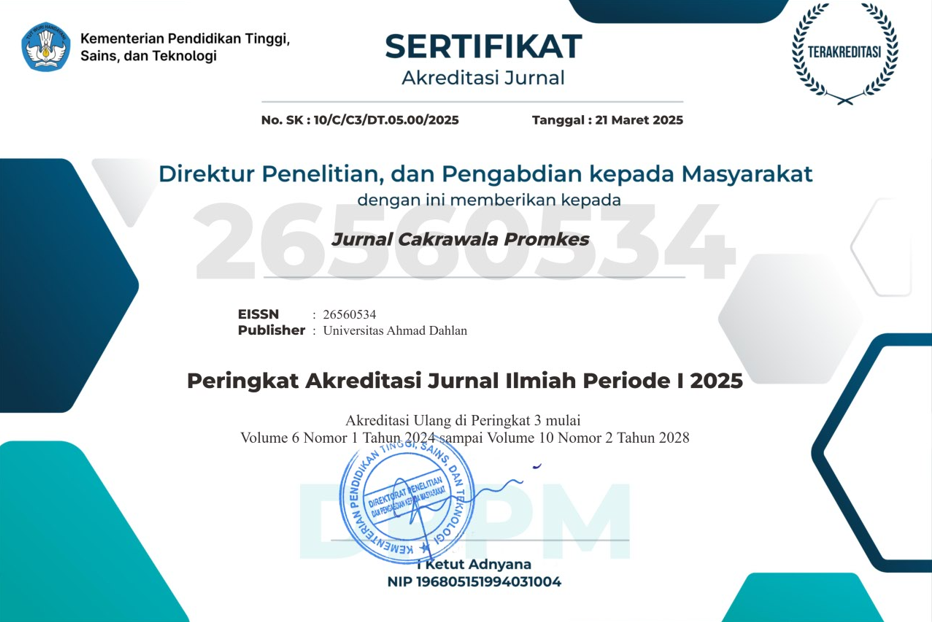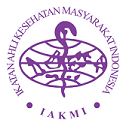Analisis perkembangan pusat informasi dan konseling remaja di Sekolah Menegah Atas Negeri 3 Bantul DIY
DOI:
https://doi.org/10.12928/promkes.v1i1.290Keywords:
Teens, PIK R, developmentAbstract
Introduction: Adolescence is a transitional period for an individual from childhood into adulthood, in the search of identity many teenagers fall into adolescent problems such as student brawl cases that occur in major cities in Indonesia, the number of drug users in adolescents reached 14 thousand people, increased cases of smokers in the age group 16 to 19 years, increase the number of early marriage every year. PIK R aims to prepare family life for teenagers. This study aims to determine the development of the Information Center and Youth Counseling program (PIK R) so that it reaches the rigorous stage. The study was conducted at SMAN 3 Bantul, because SMAN 3 Bantul is one of the schools in Region of Yogyakarta which has a PIK R called PIK R FRESS which has reached a tough stage.
Method: This research is qualitative research with descriptive research design. Research subjects were seven people who were selected by purposive sampling technique. The research was conducted by interviewing, observing, and documenting and analyzing data through the reduction, presentation and conclusion stages.
Results: The step of establishing PIK R at SMAN 3 Bantul included analyzing adolescent problems, socializing students at BKKBN, socializing the formation of PIK R in the school, so that PIK R FRESS was formed. Efforts made to support the development of PIK R are activities inside and outside of school, partnership development and Human Resources. Still found adolescent problems cause of inhibiting factors included member communication, activities of PIK R, and support from the school.
Conclusion: The step of establishing PIK R is in accordance with BKKBN guidelines, included analyzing until socializing programme. In development of PIK R, PIK R conducts human resource development, activities and partnerships. The inhibiting factors were support from schools and the problem of internal PIK R.
References
2. Ali, M., dan Asrori, M., 2014, Psikologi Remaja, PT Bumi Aksara, Jakarta.
3. KPAI, 2016, Anak Pengguna Narkoba Capai 14 Ribu, www.kpai.go.id, diakses pada tanggal 29 Maret 2018 di Yogyakarta.
4. KPAI, 2017, KPAI Minta Pemerintah Tegas Larang Iklan Rokok di Media, www.kpai.go.id, diakses pada tanggal 29 Maret 2018 di Yogyakarta.
5. PKBI DIY, 2016, PKBI DIY Perjuangkan Hak Remaja Yogyakarta, http://pkbi-diy.info, diakses pada tanggal 19 Maret 2018 di Yogyakarta.
6. BKKBN, 2012, Pedoman Pengelolaan Pusat Informasi dan Knseling Remaja dan Mahasiswa (PIK R/M), Direktorat Bina Ketahan Remaja, Jakarta.
7. Kemenkes RI, 2015, Promosi Kesehatan, Pusat Promosi Kesehatan Kementerian Kesehatan RI, Jakarta.
8. Depkes RI, 2009, Pedoman Pelayanan Kesehatan Peduli Remaja di Puskesmas, Departemen Kesehatan RI Direktorat Bina Kesehatan Anak, Jakarta.
9. Wijayanti, R., 2016, Pengelolaan Pusat Informasi Konseling Kesehatan Reproduksi Remaja di SMA Negeri 5 Yogyakarta, Jurnal Hanata Widya, Pp.89-96.
10. Yusnidar, 2017, Pengetahuan dan Sikap Siswi Kelas X dan XI tentang Kegiatan Pusat Informasi dan Konseling Kesehatan reproduksi Remaja (PIK-KRR) di MAN 1 Meulaboh Kabupaten Aceh Barat Tahun 2015, Jurnal Kesehatan Almuslim, 3(5), Pp. 24-28.
11. Indahsari, L., dan Setyowati, 2015, Implementasi Ekstrakurikuler Pusat Informasi Konseling Remaja (PIK-R) dalam Mencegah Kenakalan Remaja di SMK PGRI Sooko Mojokerto, Jurnal Kajian Moral dan Kewarganegaraan, 2(3), Pp.651-666.
Downloads
Published
Issue
Section
License
Copyright (c) 2018 Dwi Fujiastuti

This work is licensed under a Creative Commons Attribution-ShareAlike 4.0 International License.
Authors who publish with JCP: Jurnal Cakrawala Promkes agree to the following terms:
- Authors retain copyright and grant the journal the right of first publication with the work simultaneously licensed under a Creative Commons Attribution License (CC BY-SA 4.0) that allows others to share the work with an acknowledgement of the work's authorship and initial publication in this journal.
- Authors are able to enter into separate, additional contractual arrangements for the non-exclusive distribution of the journal's published version of the work (e.g., post it to an institutional repository or publish it in a book), with an acknowledgement of its initial publication in this journal.
- Authors are permitted and encouraged to post their work online (e.g., in institutional repositories or on their website) prior to and during the submission process, as it can lead to productive exchanges, as well as earlier and greater citation of published work.

This work is licensed under a Creative Commons Attribution-ShareAlike 4.0 International License












